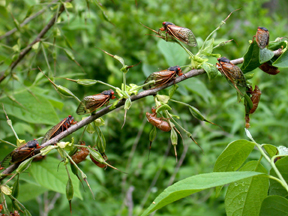 Cicadas spend
most of their 17-year life cycle belowground, feeding on the roots of trees.
Then, in May or June of their final year, the insects synchronously emerge to
sing, mate, lay eggs and die. During the six weeks the adults are aboveground,
less than 15 percent of them will fall prey to predators. The trillions remaining
die a natural death and are left to decompose on forest floors across the eastern
United States, as much of the East Coast learned last year. Now, scientists
say that the massive die-off fertilizes forests.
Cicadas spend
most of their 17-year life cycle belowground, feeding on the roots of trees.
Then, in May or June of their final year, the insects synchronously emerge to
sing, mate, lay eggs and die. During the six weeks the adults are aboveground,
less than 15 percent of them will fall prey to predators. The trillions remaining
die a natural death and are left to decompose on forest floors across the eastern
United States, as much of the East Coast learned last year. Now, scientists
say that the massive die-off fertilizes forests.Cicadas from Brood IX, shown here in Athens, W.V., last emerged in 2003. Image courtesy of Louie H. Yang. Below: In May and June 2004, the insects of Brood X covered territory from Georgia north to New York and as far west as the Mississippi River. Scientists say that cicada carcasses fuel forest growth. Image by Megan Sever.
 Although tree
growth slows down in a cicada emergence year, it speeds up in the following
four years. Some scientists have suggested that the damage done to the trees
by the cicadas feeding off of them allows more sunlight into the forest, while
others have contended that the cicada carcasses themselves fuel forest growth.
Although tree
growth slows down in a cicada emergence year, it speeds up in the following
four years. Some scientists have suggested that the damage done to the trees
by the cicadas feeding off of them allows more sunlight into the forest, while
others have contended that the cicada carcasses themselves fuel forest growth.
Reporting in the Nov. 26 Science, ecologist Louie H. Yang of the University of California, Davis, says that the dead cicadas do indeed impart a “resource pulse” — a periodic “superabundance” of nutrients that influences tree growth. Such “bottom-up cascades” of nutrients, Yang says, are a strong, yet overlooked, link between the underground components of a forest ecosystem and those above.
“Yang’s work demonstrates how organisms and materials flow inexorably from bottom to top and back again,” writes ecologist Richard S. Ostfeld of the Institute of Ecosystem Studies, Millbrook, New York, in a commentary in Science.
Yang seeded experimental forest plots with up to 300 cicada carcasses per square meter, which is a natural range. When compared to control plots, the cicada-seeded plots showed increased amounts of soil microbes, fungi and soil nitrogen, a nutrient that is a limiting factor for plant growth. Additionally, Yang added cicadas to plots of American bellflower plants, a species that commonly grows in the forest understory of the cicadas’ geographic range. The cicada-seeded plots exhibited bellflower plants with larger seeds and leaves with higher nitrogen content, which Yang was able to trace from the cicadas by using an isotope of nitrogen.
In related research, soil scientists are investigating how cicada carcasses can indicate contaminants in the environment. Reporting at the fall meeting of the American Geophysical Union in December, Gilpin R. Robinson of the U.S. Geological Survey in Reston, Va., along with Yang and others, said that because the adult cicadas rarely travel more than 50 meters from where they emerge from the soil, the keratin in their bodies and exoskeletons has potential value as an indicator of arsenic and other heavy metal contamination.
Sara Pratt
Geotimes contributing writer
Back to top

